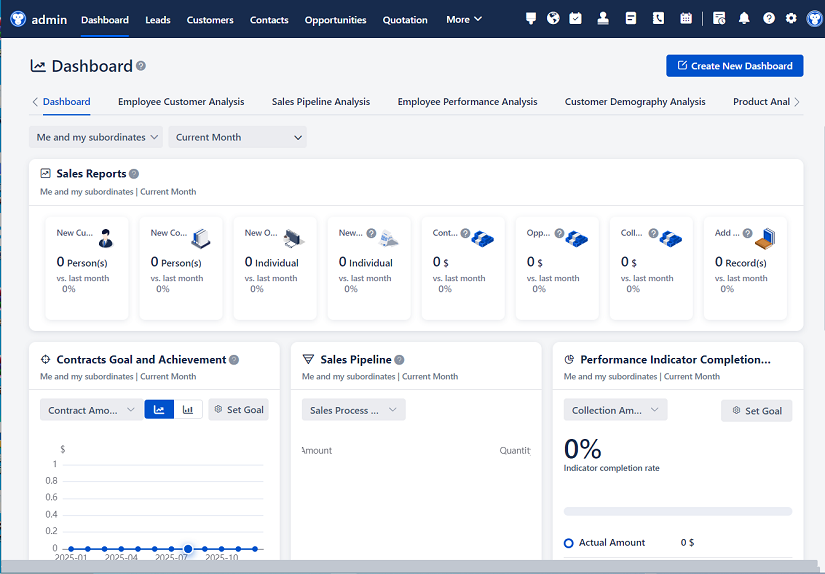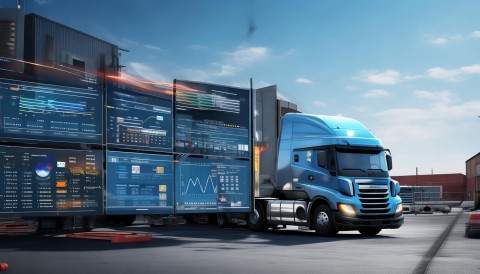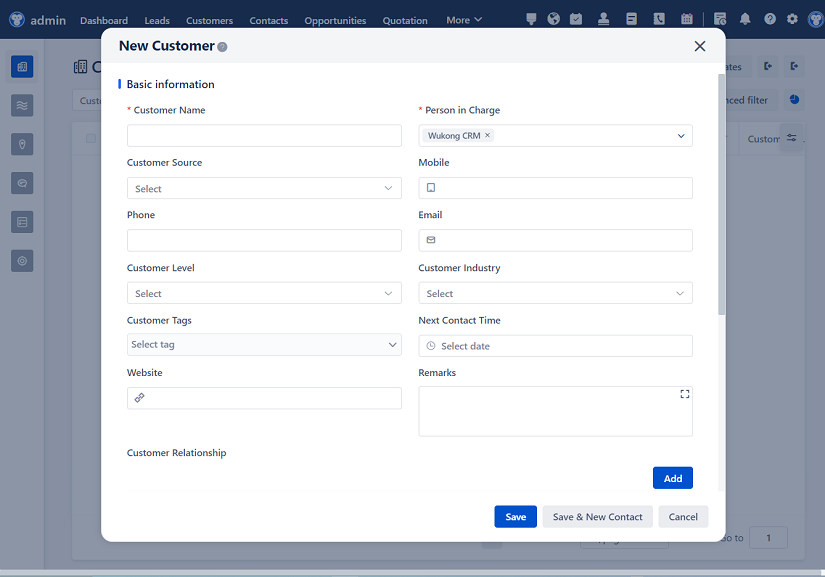
△Click on the top right corner to try Wukong CRM for free
So, let me tell you about this really interesting case study I came across recently—yeah, the one about how a major heavy truck group implemented a CRM system. Honestly, it’s not the kind of thing you’d expect to get excited about, right? But once I started digging into it, I realized just how much this kind of technology can actually change the game for big industrial companies.
You know, when you think about heavy trucks, you probably picture massive vehicles on highways or construction sites. But behind the scenes, there’s a whole world of sales, service, customer support, and logistics that keeps everything running. And that’s exactly where CRM—Customer Relationship Management—comes into play.
Free use of CRM system: Free CRM
This particular company, which I’ll just call “HeavyTruck Group” to keep things simple, had been struggling for years with scattered customer data. Sales teams were using spreadsheets, service departments had their own logs, and marketing was basically guessing who to target. It was a mess. Like, seriously—imagine trying to run a restaurant where the kitchen, waitstaff, and cashier all use different notebooks. That’s how disconnected their systems were.
So they decided it was time for a change. They wanted a unified system—something that could bring all customer interactions into one place. That’s when they started looking into CRM platforms. Now, I’ll be honest, they weren’t exactly tech-savvy at first. The leadership team was a bit skeptical. One of the senior managers even said, “We’ve been doing fine without this for 30 years—why fix what isn’t broken?” But the younger execs pushed back, arguing that customer expectations were changing. People wanted faster responses, personalized service, and transparency. And honestly, they had a point.
After a few months of research and demos, they picked a CRM system that could be customized for their industry. It wasn’t just an off-the-shelf solution—it had features tailored for equipment tracking, service scheduling, warranty management, and even parts inventory. That was a big deal because, in the heavy truck business, a lot of customer value comes from after-sales service. Think about it: if your truck breaks down in the middle of nowhere, you don’t care about the sales pitch from six months ago—you care about getting it fixed fast.
The rollout wasn’t smooth, though. I mean, come on—when is it ever? There was resistance from the field teams. Some sales reps hated entering data after every customer visit. Mechanics didn’t see why they needed to log every repair detail into a computer. And let’s not even talk about the training sessions—half the staff showed up late, and a few just nodded along without really getting it.
But here’s the thing: the company didn’t give up. They brought in change management consultants—real pros who knew how to handle organizational pushback. They started with pilot teams in two regional offices. These teams got extra training, incentives, and direct access to the IT support team. And guess what? Within three months, those pilot teams were seeing real benefits. Sales leads were being followed up faster. Service appointments were scheduled more efficiently. Customer satisfaction scores started creeping up.

That success gave the leadership the confidence to roll it out company-wide. They made it mandatory, but they also made it easier. They simplified the user interface, added mobile access so field reps could update records from their trucks, and even gamified some parts of data entry—like giving badges for completing customer profiles. Sounds silly, maybe, but it worked. People started using the system because it actually made their jobs easier, not harder.
One of the coolest things they did was integrate the CRM with their telematics system. Yeah, that’s the tech that tracks vehicle location, engine performance, fuel usage—you name it. So now, when a truck shows signs of trouble, the CRM automatically flags it and alerts the service team. They can even reach out to the customer before the driver even notices a problem. Imagine getting a call saying, “Hey, we noticed your engine temperature is spiking—want us to schedule a check-up?” That’s next-level service.
And it paid off. Within a year, customer retention went up by 18%. Sales cycle time dropped by nearly 30%. The marketing team finally had clean data to work with, so their campaigns became way more targeted. Instead of blasting generic emails to everyone, they could send personalized offers based on vehicle age, usage patterns, or service history. One campaign for pre-winter maintenance saw a 40% response rate—way above industry average.
But it wasn’t just about numbers. The culture started to shift too. People began thinking more about the customer journey. Sales reps started checking service history before making a pitch. Service advisors began asking about future needs during routine repairs. It became less about individual transactions and more about long-term relationships.
Now, of course, there were still challenges. Data migration was a nightmare at first—tons of old records had to be cleaned and uploaded. Some regional offices had spotty internet, which made real-time syncing tricky. And there were moments when the system crashed during peak hours, which, let’s be honest, caused some serious frustration.
But the company learned from those hiccups. They invested in better infrastructure, set up offline modes for remote areas, and created a dedicated CRM support desk. They also set up regular feedback loops—monthly meetings where users could suggest improvements. One mechanic even proposed a feature that lets him attach photos of damaged parts directly to service tickets. It was added in the next software update.
Another big win was visibility. Before the CRM, executives were basically flying blind. They’d get monthly reports that were outdated or inconsistent. Now, with real-time dashboards, they could see everything—sales pipelines, service backlogs, customer satisfaction trends. One VP told me, “It’s like we finally got headlights on a dark road.”
And here’s something I found really surprising: the CRM helped them identify new revenue streams. By analyzing customer data, they noticed that a lot of fleet operators were struggling with driver training. So they launched a new service—on-site driver safety and efficiency workshops. It wasn’t something they’d ever considered before, but the data made it obvious.
They also improved their warranty management. Previously, warranty claims were a paperwork nightmare. Now, the CRM automatically verifies eligibility, tracks claim status, and even flags potential fraud. That saved them millions in unnecessary payouts.
Looking back, the biggest lesson seems to be this: technology alone isn’t enough. You can have the fanciest CRM in the world, but if your people don’t buy in, it’s just expensive software sitting on a server. The real success came from combining the right tool with training, leadership support, and a willingness to adapt.
Oh, and one more thing—security. They took it seriously from day one. With all that customer and vehicle data, they couldn’t afford a breach. So they implemented multi-factor authentication, encrypted data storage, and regular audits. They even ran phishing simulations to train employees. Smart move.
So, what’s the bottom line? This CRM wasn’t just a tech upgrade—it transformed how the company operated. It improved customer experience, boosted efficiency, and even opened up new business opportunities. And honestly, I think other industrial companies could learn a lot from this example. It’s proof that even in traditional, hardware-heavy industries, digital tools can make a huge difference.
Sure, the journey wasn’t perfect. There were setbacks, doubts, and late nights. But in the end, the team pulled it off. And now, when customers call, they’re not just another ticket number—they’re recognized, understood, and valued. That’s what a good CRM should do.
FAQs (Frequently Asked Questions)
Q: Why did the heavy truck group need a CRM in the first place?
A: Because their customer data was all over the place—spread across spreadsheets, paper logs, and different departments. They needed a single system to manage sales, service, and customer interactions more efficiently.

Q: Was the CRM system expensive to implement?
A: It wasn’t cheap, but they viewed it as a long-term investment. The cost included software licensing, customization, training, and infrastructure upgrades. But the ROI became clear within the first year through improved sales and service efficiency.

Q: Did all employees embrace the CRM right away?
A: Not at all. There was significant resistance, especially from field staff who were used to old ways of working. But with proper training, incentives, and ongoing support, adoption improved steadily.

Q: How did the CRM help with after-sales service?
A: It centralized service records, automated maintenance reminders, integrated with vehicle telematics, and streamlined warranty claims—making it easier to deliver fast, proactive service.
Q: Can small trucking companies benefit from CRM too?
A: Absolutely. While this case involved a large group, even smaller fleets can use simpler CRM tools to track customers, manage service schedules, and improve communication.
Q: What role did leadership play in the CRM’s success?
A: Huge role. Without buy-in from top management, the project might have stalled. Leaders championed the change, allocated resources, and held teams accountable for adoption.
Q: Did the CRM improve customer satisfaction?
Yes, significantly. Faster response times, personalized service, and proactive maintenance alerts led to higher customer retention and better satisfaction scores.
Q: How long did it take to see results?
They started seeing early wins in the pilot phase (around 3 months), but full benefits—like increased retention and shorter sales cycles—became clear after about a year.
Q: Was the CRM customized for the trucking industry?
Yes, it was tailored to handle equipment tracking, service history, parts inventory, and integration with telematics—features that generic CRMs don’t always support well.
Q: What advice would you give to other companies considering CRM?
Start with clear goals, involve users early, invest in training, and don’t underestimate the human side of change. Technology is just one piece of the puzzle.
Related links:
Free trial of CRM
Understand CRM software

△Click on the top right corner to try Wukong CRM for free